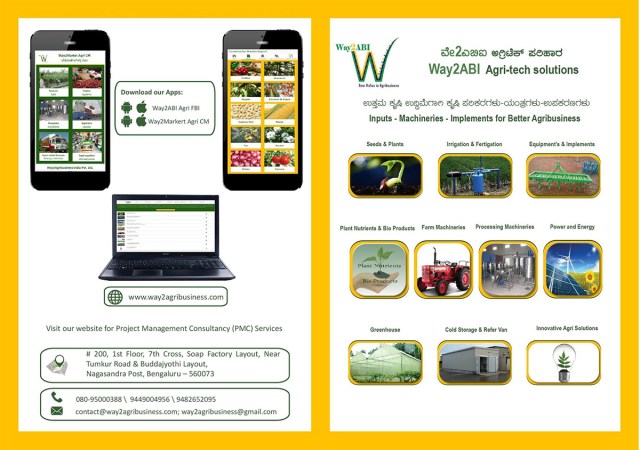
For an agricultural enthusiast like me, participating in the 8th Agritech India 2016 trade expo was quite an enlightening experience since the event presented all the diverse aspects of agriculture all in one place. The event showcased dedicated exhibitions like GrainTech India, DairyTech India and MeatTech Asia, visitors could witness the diversification of Indian agriculture in terms of farm machinery, poultry equipment, livestock management, food processing technologies, etc. Urbanites like me who are constantly fed with media reports on farmer suicides and dismal state of Indian agriculture, the Agritech India expo was truly an eye opener to the immense business opportunities opening up in this sector!
The majority of stalls displayed regular features such as hybrid seeds, greenhouse equipment, irrigation and water management services, and other latest mechanization tools and product ranges. However, there were a few companies that presented some technological innovations that were not only interesting but also could change the game for the established market players. Here are some of the agri tech innovations showcased at the Agritech India 2016 trade expo that were noteworthy for their innovativeness and eco-friendly aspects:
Sxtreo GPS devices

We all own handheld computing devices such as tablets, smartphones, but many of us don’t use them in the countryside and rugged terrains due to the fear of damage. Particularly, farmers and field executives need a sturdy device that can withstand physical shocks, water spillage and dust intrusion. Stesalit Systems is a Kolkata-based electronic manufacturer that has created a range of products named ‘Sxtreo’ for a wide range of field applications such as agro-farms, forest survey, mining, etc.
Sxtreo is a rugged GPS handheld device with integrated camera for geotagging and global navigation satellite systems (GNSS). It is shock resistant, waterproof and dustproof and has robust multi-tasking capabilities that is engineered to perform in harsh environments such as mines, farms, forests, etc. this smartphone has a large touch screen and has great battery backup. Currently, the Odisha Forest Dept has purchased a set of devices for its forest rangers to accurately survey the rugged terrain. However, the high cost of INR30,000+ will be a major hurdle for larger market acceptability among farmers.
Way2Agribusiness Mobile App

Typically the two biggest hurdles faced by Indian farmers are predicting the market price for their crops during the sowing season and getting handholding support from expert consultants and financiers when they implement new crop varieties. However, the Indian agricultural sector is the most neglected industry in terms of service providers and project consultants. Thankfully, new tech-enabled players like Way2Agribusiness India Pvt. Ltd. are entering the market to provide the much needed support to farmers.
Way2Agribusiness is a mobile app-based offering that provides a range of services including agribusiness incubation, project management consultancy, market intelligence and trading platform. For instance, Way2Agribusiness offers live demos of innovative agribusiness operations to establish their proof of concept, which helps businessmen to take up new opportunities and mitigate any problems. Similarly, farmers get help from specialized experts who act as project managers to implement turnkey projects. Finally, market trends on crop prices and yield pattern are analyzed to provide market intelligence. Right now, this service is offered to farmers in Karnataka for 10 prominent crops such as coffee, arecanut, pepper, coconut, maize, cotton, etc.
Neem Coated Fertilizers

Petro-chemical based nitrogen fertilizers such as Urea dissolve fast in water leading to leaching in water logged fields. Further, their hydrolysis reaction is too fast for plants to absorb nitrogen from the soil in a sustained manner. This loss forces farmers to use excess amounts of urea, which has caused extensive groundwater contamination and high salinity in soil. Thankfully, an innovative solution of coating nitrogen fertilizers with polymers, sulfur or neem provides for a slow or controlled release.
Indian fertilizer companies have begun coating urea with neem, which is a natural pest repellant and a cheap bio-pesticide. Neem has properties that check nitrogen loss at each stage by slowing down the process of nitrate formation and hence excess nitrate is not available for denitrification. Field trials in three states showed positive results with an average increase of 16% in crop production. In 2015, the Indian government has made it mandatory for fertilizer manufacturers to produce neem-coated urea up to 75% of their total production of subsidized urea. However, critics of this policy state that subsidized urea is preventing farmers from using vermi-compost and farm-manure, and move to organic farming.
Climate Smart Agriculture

Climate change is one of the most significant factors that are aggravating the current crisis in Indian agriculture. Further, climate risks are increasing at a rapid rate to threaten cropping patterns and cause reduction in food grain productivity. Thankfully government agencies such as ISRO, ICRISAT and Indian Institute of Tropical Meteorology are working with local gram panchayats to create climate smart villages in Telangana and Karnataka!
ICRISAT’s Resilient Dryland Systems team have assessed scenarios for various cropping options with the APSIM simulation model using historical weather patterns, major ocean influences and crop productivity data for 40 seasons. Such forecasts are highly probabilistic and are more likely help farmers enhance productivity in years of good rainfall and limit investment risks during year of low rainfall. Meanwhile, a team led by P. P. Nageswara Rao from ISRO has used drones to map farms at the village level and take remote sensing images to study disease pattern, fertilizer usage and drought impact across farms. When farmers are helped with such data, they can plan a year ahead and sow suitable drought-resistant crops.




















Here in my place I have cattle breeding and I suffer a lot with the lack of rain, had to impart irrigation, but I loved the ideas.